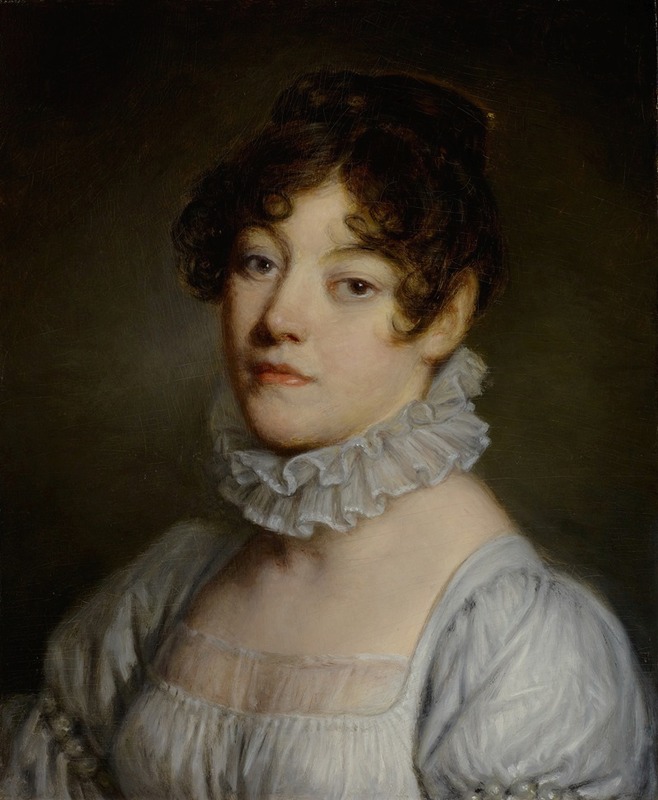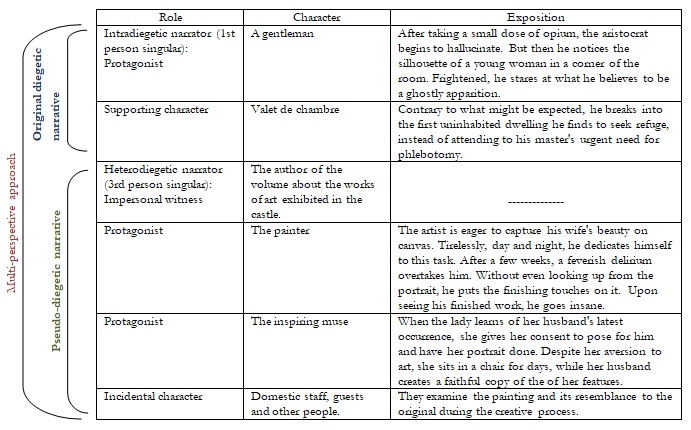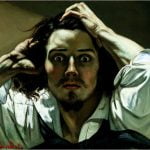Article made by Eleonor Nolan,
Jul 29, 2025.
Literary theory:

Jean-Baptiste Greuze (French, 1725-1805). Downloaded from https://artvee.com/dl/portrait-of-a-young-woman-90/
In literary theory, there is a discipline called “narratology[i]”, a term coined by the Bulgarian-French philologist Tzvetan Todorov in his work “Grammar of the Decameron”, published in 1969. This study analyzes the structure of the tales from “The Decameron”, written by Giovanni Boccaccio between 1349 and 1353[ii] in the Middle Ages. This contribution by Tzvetan Todorov marked a turning point in the field of semiotics. Some of the most commonly used terms in “narratology”, as defined by the Oxford English Dictionary, Merriam-Webster Dictionary and Cambridge Dictionary, are:
- Diegesis:
- “A narrative; a statement of the case”; Oxford English Dictionary.
- “The relaying of information in a fictional work (such as a film or novel) through a narrative”, “also : the fictional world in which the events of a narrative occur”; Merriam-Webster Dictionary.
- “The plot (= story) of a film or TV programme”; Cambridge Dictionary
- Diegetic:
- “Of or pertaining to diegesis”; Oxford English Dictionary, and Merriam-Webster Dictionary.
- “Especially : existing or occurring within the world of a narrative rather than as something external to that world”; Merriam-Webster Dictionary.
In 1972, the French literary theorist Gerard Genette issued an article titled “Narrative Discourse: An Essay on Method”. Originally published in the 3ʳᵈ volume of the “Figures” series, it explores a number of concepts that have changed our understanding of what narrative is. One of these is “Narrative voice”, i.e. the human being or creature that gives an account of the events as they unfold. To understand this idea, Gerard Genette identifies three levels of narration, seeking to answer two questions: From whose perspective is the story being told, and who is telling it. As Mieke Bal points out in “Narratology: An Introduction to the Theory of Narrative”, printed in 1982, Genette’s hierarchy would be more accurate if the term “metadigetic” were used instead of “hypodiegetic”.
- Extradiegetic[iii]: According to the point of view (3ʳᵈ person singular)/
Heterodiegetic: According to the involvement in the story (3ʳᵈ person singular)- Omniscient Narrator: Observes and narrates the events as an all-knowing supreme being would. He is “God.” He is not a character in the story.
- Equiscient Narrator: Observes and narrates the events as an entity anchored to the point of view of one of the characters, becoming aware of the events at the same time as the other. He is not a character in the story.
- Witness Narrator:
- Impersonal: Observes and narrates the events as a passerby who does not participate in them might. He is not a character in the story.
- Informant: Observes and narrates the events as a journalist or detective would who has gathered information about them. He is not a character in the story.
- Intradiegetic[iii],[iv]: According to the point of view (1st person singular)/
Homodiegetic: According to his involvement in the story (1st person singular)- Protagonist Narrator: He is both the narrator and the main figure.
- Personal Witness Narrator: A secondary character who recounts the events that took place.
- Hypodiegetic Level[v]: Frame Story and Matryoshka Doll Set (A story within a story). It can be either extradiegetic or intradiegetic, or both.
Edgar A. Poe’s “The Oval Portrait”, has a multi-perspective approach. Throughout the story, the protagonist invites the reader to examine the aesthetic details of an old painting. Furthermore, a brief guide to each artwork gives an overview of what led to its creation. That being said, it’s actually possible to argue that this story isn’t a multi-perspective approach at all, given the fact that one of the points of view ignores the entire event itself. While this is true, it’s still providing us with a glimpse of how real the situation is.
Thus, “The Oval Portrait” is told by two narrators, whose identities are as follows: Firstly, a man, who speaks in the 1st person singular to the reader, portraying himself as the protagonist. Secondly, a 3ʳᵈ person singular observer that writes a report on some tragic events. Because of its limited participation in the plot, the latter gets labeled as an “impersonal witness”. However, given its language, it should be referred to as a “personal witness”, since it expresses a sense of connection to the story’s characters.
A final note of distinction about “The Oval Portrait” is that it illustrates a “hypodiegetic” narrative style, in which a lower-level story is nestled within a higher-level one. It’s a perfect example of a frame story.

This article is linked to the following one: Click here
[i]It is by analyzing their various elements and, consequently, their structure that short stories, novels, etc., can be understood. In one and other, prose is used almost exclusively.
[ii]Some scholars assume that the “Decameron” was written between 1349 and 1351, while others believe that Giovanni Boccaccio devoted himself to this work between 1351 and 1353.
[iii]It should be noted that this classification refers to the physical location of the narrator, so to speak, as well as that of the narrative. However, this hierarchical system introduced by Gerard Genette is unnecessary and redundant, as each term is linked to a single narrative level. Therefore, to avoid confusion, it would be more than sufficient to use extradiegetic and intradiegetic terms, rather than additional ones.
[iv]At the Intradiegetic Level, the autodiegetic narrator has been excluded due to its complexity. An autodiegetic narrator is one who uses the 2nd person singular. They are also the protagonist, so, strictly speaking, the Intradiegetic Level has two 1st person singular narrators and one 2nd person singular narrator.
[v]A frame story has a a higher-order main narrative that introduces a lower-order narrative, which ultimately becomes the main narrative. Furthermore, only the lower-order narrative has a three-act structure i.e. the introduction, the confrontation and the resolution. On the contrary, when it’s a story within a story (or nested stories), the higher-order main narrative has a three-act structure, as do the second, third, or fourth lower-order narratives.
Bibliography:
Decameron. Encyclopedia Britannica. Downloaded from: https://www.britannica.com/topic/Decameron
Frame narrative. Oxford Reference. Downloaded from: https://www.oxfordreference.com/display/10.1093/oi/authority.20110803095832133
Frame story. Encyclopedia Britannica. Downloaded from: https://www.britannica.com/art/frame-story
Frame Story vs Nested Narrative: Unraveling Stories Within Stories. LitDevices. Downloaded from: https://litdevices.com/difference/frame-story-vs-nested-narrative/
Gérard Genette. Oxford Reference. Downloaded from: https://www.oxfordreference.com/display/10.1093/oi/authority.20110803095847733
Gérard Genette; by Benson, Alvin K. EBSCO. Downloaded from: https://www.ebsco.com/research-starters/literature-and-writing/gerard-genette#:~:text=G%C3%A9rard%20Genette%20was%20a%20prominent,at%20the%20Sorbonne%20in%201963
Genette, Figures III (summary) – Diegesis: What is it? Narrative? History? And/or narration? [Language: Spanish]; by Ara Celi. 5 Metros de Poemas. Downloaded from: https://www.5metrosdepoemas.com/traducciones/76-linguistica-semiologia/646-genette-figuras-iii-resumen-la-diegesis-que-es-relato-historia-y-o-narracion
Giovanni Boccaccio’s The Decameron. The Public Domain Review. Downloaded from: https://publicdomainreview.org/collection/the-decameron/#p-2-0
Guide to the Classics: Boccaccio’s Decameron, a masterpiece of plague and resilience; by Frances Di Lauro. The Conversation. Downloaded from: https://theconversation.com/guide-to-the-classics-boccaccios-decameron-a-masterpiece-of-plague-and-resilience-143437
Glossary of narratological terms. Universitá di Torino. Downloaded from: https://elearning.unito.it/scienzeumanistiche/pluginfile.php/453794/mod_resource/content/1/Fludernik-Glossary%282009%29.pdf
How to create a story structure. BITESIZE, BBC. Downloaded from: https://www.bbc.co.uk/bitesize/articles/zk8qnrd#z8rmywx
Mieke Bal [Language: Spanish]. Círculo de Bellas Artes de Madrid, Casa Europa. Downloaded from: https://www.circulobellasartes.com/biografia/mieke-bal/
Multiperspectivity; by Marcus Hartner. Interdisciplinary Center for Narratology. University of Hamburg. Downloaded from: http://lhn.sub.uni-hamburg.de/index.php/Multiperspectivity.html
Narration; by Woltag, Laura. EBSCO. Downloaded from: https://www.ebsco.com/research-starters/literature-and-writing/narration
Narrative structure; by Biscontini, Tyler. EBSCO. Downloaded from: https://www.ebsco.com/research-starters/literature-and-writing/narrative-structure
Narrative writing; by Kennedy, Adrienne. EBSCO. Downloaded from: https://www.ebsco.com/research-starters/literature-and-writing/narrative-writing
Narratology. Encyclopedia Britannica. Downloaded from: https://www.britannica.com/art/narratology
Narratology; Kivak, Rebecca. EBSCO. Downloaded from: https://www.ebsco.com/research-starters/literature-and-writing/narratology-literary-theory
Narrator; by Dziak, Mark. EBSCO. Downloaded from: https://www.ebsco.com/research-starters/literature-and-writing/narrator-literature
Narrator [Language: Spanish]; by Raffino, Equipo editorial, Etecé [Aug 5, 2021]. Enciclopedia Concepto. Downloaded from: https://concepto.de/narrador/#:~:text=En%20narrativa%20y%20literatura%2C%20se,puede%20haber%20relato%20sin%20narrador
Plot; by Eliassen, Meredith. EBSCO. Downloaded from: https://www.ebsco.com/research-starters/literature-and-writing/plot-narrative
Point of view; by Eliassen, Meredith. EBSCO. Downloaded from: https://www.ebsco.com/research-starters/literature-and-writing/point-view-literature
Types of narrator [Language: Spanish]; by Farías, Gilberto [Nov 26, 2023]. Enciclopedia Concepto. Downloaded from: https://concepto.de/tipos-de-narrador/
Tzvetan Todorov. New Humanist. Downloaded from: https://newhumanist.org.uk/contributors/1625/tzvetan-todorov
Tzvetan Todorov, Literary Theorist and Historian of Evil, Dies at 77; by Sewell Chan [Feb 7, 2017]. New York Times. Downloaded from: https://www.nytimes.com/2017/02/07/world/europe/tzvetan-todorov-dead.html
Tzvetan Todorov [Language: Spanish]. Princess of Asturias Foundation. Downloaded from: https://www.fpa.es/es/premios-princesa-de-asturias/premiados/2008-tzvetan-todorov/?texto=trayectoria

